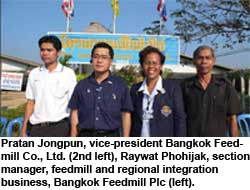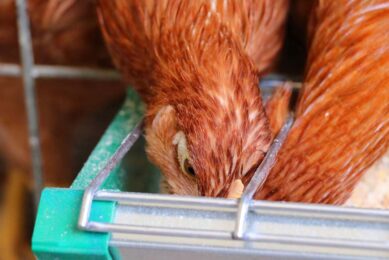Renewable energy satisfies school’s farm and community

Wat Sa Kaew school’s biogas collection system allows a saving on its electricity bill, as well as a better relationship with its neighbours. The system, which captures methane gas from composted manure and burns it in a generator, has virtually eliminated complaints from the neighbourhood regarding horrible odours emanating from the school’s poultry operation.
By Apisit Buranakanonda, Bangkok, Thailand
Wat Sa Kaew school, founded in Ang Thong province in Thailand in 1942, is an orphanage housing and caring for 1,195 children. Run by Buddhist monks, it is the country’s oldest private orphanage. Most importantly, the school demonstrates to the public that sustainable farming and social responsibility go hand in hand.
Contract grower
The school’s poultry operation first began with 100 layer hens reared in open-sided housing in 2000. The flock gradually expanded and became a full-scale industrial operation in 2005. Dhanin Chearavanont, Charoen Pokphand Foods chairman, donated over UD$500,000 to the school to build poultry housing and provide equipment to operate a modern layer farming operation.
The farm operates as one of Charoen Pokphand Foods Plc’s 1,000 contract growers in the country. CPF supplies 18-week-old pullets at an average weight of 1.4 kg, and buys the eggs that they lay.
Each house has three-tier, A-frame battery cages, with four layers in each partition. The birds are automatically fed five times a day via a moving feed dispensing hopper and watered with nipple drinkers.
Constraints
One of the school’s major constraints is its compact size, with four layer houses (15m x 88m) crammed into an area of only 1.28 ha. The farm is surrounded by the school and the community nearby. As the flock expanded, the surrounding community began to complain about flies and offensive odours.
Utilising methane
The farm’s roughly 75,000 birds produce up to 7.5 tonnes of manure each day. Like all manure, poultry waste releases methane and other gases as it decomposes. By placing a cover on the lagoon storage area, the methane – a potent greenhouse gas – is collected and can be used as a renewable source of energy.
After the manure is removed from the houses each morning, it is mixed with 35 cubic metres of water and pumped into a digester pond (30m x 38m x 6m) which is covered with an airtight and impermeable high-density polyethylene (HDPE) sheet. The effluent from the layer house bears a Chemical Oxygen Demand (COD) load of more than 9,000 mg/litre and Biological Oxygen Demand (BOD) 5,000 mg/l. BOD and COD are measurements of water quality. The higher the load of organic matter (an indication of inferior water quality) the higher the BOD and COD value.
The system is designed to prevent the excess build-up of grit, which is normally supplemented in layer feed, which can shorten the operable lifespan of the digester. The effluent flows to the digester via a v-shape duct which is designed to trap the grit supplemented in the feed.
Sludge into fertiliser
To further minimise their environmental footprint and save water, the school plans to recycle some of the water flowing from the expansion chamber to remix with fresh manure. In the digester, the low-pressure methane and other gases push the slurry at the bottom of the floor into the expansion chamber (30m x 50m x 5m). At this point, the BOD and COD load has declined 10-fold to below 500 mg/l. When the gas is drawn off, the effluent flows back into the digester chamber. Every two months, when the effluent level exceeds the holding volume of the chamber, it is drained out and collected in a pond. The sludge, by now virtually odourless, is taken out and dried in the sun and sold as high-quality organic fertiliser.
Electricity costs down
The liquid effluent is further processed in a treatment pond (30m x 60m x 5m). At the end, BOD and COD is reduced to below 150 mg/l, which is on par with emission standards.
The biogas contains methane (65%), carbon dioxide (33%) and hydrogen sulphide (2%). Gas scrubbers clean out the hydrogen sulfide, a corrosive component, which can damage the manifolds and the intake system of the generator.
The farm uses two 90 KVA generator sets that operate on an alternating basis. The digester produces 840 cubic metres of methane a day, which is sufficient for running a single generator set for 20 hours/day. This has reduced the school’s monthly electricity bill by 75% down to US$700 from $2,600 previously.
Good return on investment
So far, the results have been satisfactory. At current electricity costs, the US$61,000 investment in the covered lagoon digester, generators and piping system is expected to be recouped within two years. With the manure odour problem taken care of, the school’s focus has shifted to controlling the ammonia produced by the poultry housing in order to improve the farm’s operation and maintain a good relationship with the community in the long run. To tackle the ammonia problem, a paper filter has been installed at one end of each of the houses which is sprayed with diluted sulphuric acid (pH5) to trap and neutralise ammonia and other offensive odours. The filter has slowed down air speed at the rear of the layer house only slightly, down to 430 ft/min vs 450 ft/min prior to installation.
With all these modifications, the birds are still doing well. At week 56 (depletion at week 60), mortality is still below 4%, with eggs-per-hen day 98%, and egg/hen housed 75%. Also, the birds listen to music from 06.00 to 18.00 to drown out unfamiliar noise from the surrounding area. Presently, trials are running to find the best way to keep ammonia levels in the houses below 1 part per million (ppm). Materials such as charcoal or eucalyptus wood are being tested. So far, the results have been promising.
Join 31,000+ subscribers
Subscribe to our newsletter to stay updated about all the need-to-know content in the poultry sector, three times a week. Beheer
Beheer








 WP Admin
WP Admin  Bewerk bericht
Bewerk bericht